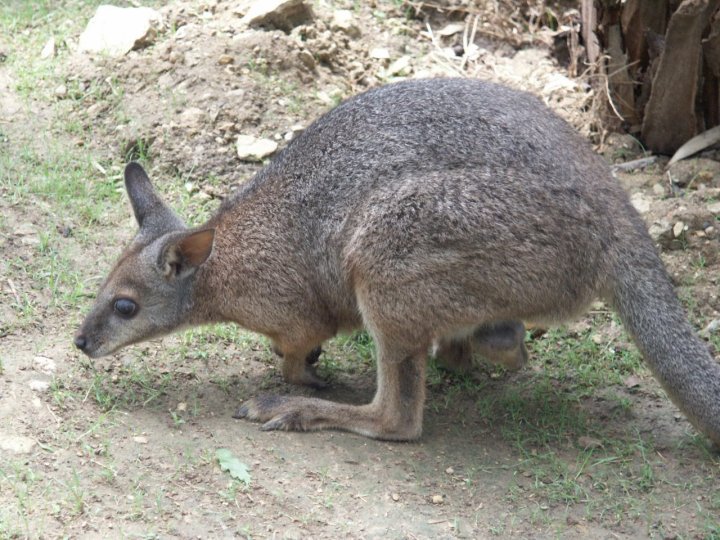
There are many different species of wallabies, but the dama wallaby are just a little different from the rest. They are mostly nocturnal animals in the wild, but they do forage and catch some sun during the day. They have small front legs having five digits with a sharp claw. Their hind legs are very powerful and much larger. Their hind legs have four toes with the end ones being much smaller than the middle ones. The smaller toes have double claws which they use as a comb. They have long tails which they use for balance when leaping and as a third leg when sitting. The head and body length is about 26 inches, with a tail about 15 to 17 inches long. They sit about 18 inches tall and weigh between 9 and 22 pounds. They are usually dark brown or gray looking, with short rough fur. Males are usually larger than females because they grow a little faster when maturing.
Dama wallabies, in the wild are usually solitary or in pairs. When I visited the wallabies at the zoo they didn't want to seem to interact with one another. They are mostly very solitary animals. The only social groupings are between the females and their young.
Dama wallabies give a warning thump with their hind legs when they feel
that they are in danger. Because they are mostly nocturnal in the
wild they are able to survive better. Their size is another contributing
factor to their survival, because they are small they can hide in tall
vegetation from
predators. Dama wallabies are also known to be kept as pets because
they are small and fairly easy to keep. They can live up to 28 years
in captivity and up to 18 in the wild. An unusual trait about the
Dama wallaby is that it mostly sits on its tail. Instead of the
tail dragging behind like most animals, the Dama wallaby sits on its tail
with it being straight in front.

The dama wallabies breeding season is January to June or August. Males are sexually mature at two years and females are sexually mature at nine months. The gestation period for dama wallabies is twenty eight days. The newborn joey climbs into the pouch on its own and feeds until it is ready to look out into the world. The joey's usually do not peak out of their mothers pouches until they are about 150 days old.
When I visited the Dama Wallaby at the zoo there were three in the exhibit. Two were resting and one was eating. They seemed like very calm animals, but did not interact very much with one another.
Bernadette Robles: brobles2001@hotmail.com
Sources and Links:
Graves, Eleanor. Kangaroos & Other Creatures from Down Under.
USA: Time-Life Films, 1977.
Storer, Tracy I., "Wallaby." Encyclopedia AMERICANA International Edition. Connecticut: Grolier Incorporated, 1989.
"Wallaby." Encyclopedia Britannica. 1987 ed.
www.scz.org/animals/w/wallaby.html